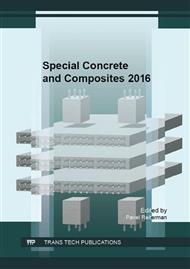p.113
p.121
p.126
p.132
p.140
p.146
p.151
p.157
p.163
Impact of Milling Intensifiers on Specific Surface Area of Cement
Abstract:
Milling of cement is one of the more demanding procedures in cement production. During milling process, fine particles have tendency to aggregate. This paper focuses on effect of intensifiers of milling. Conventional industrial intensifiers, as well as clean basis, as are glycerol or triethanolamine were used. Milling took place in laboratory planetary mill. Mixtures with intensifiers increased their specific surface area faster than reference in first 10 minutes of milling, but after 20 minutes specific surface area of all mixtures reached maximal values. Additional milling caused reduction of specific surface area. This effect was less pronounced when intensifiers were used. Usage of intensifiers has many benefits, but it should be considered in relation to the used mill and ecological situation.
Info:
Periodical:
Pages:
140-145
Citation:
Online since:
December 2016
Authors:
Keywords:
Price:
Сopyright:
© 2017 Trans Tech Publications Ltd. All Rights Reserved
Share:
Citation:


